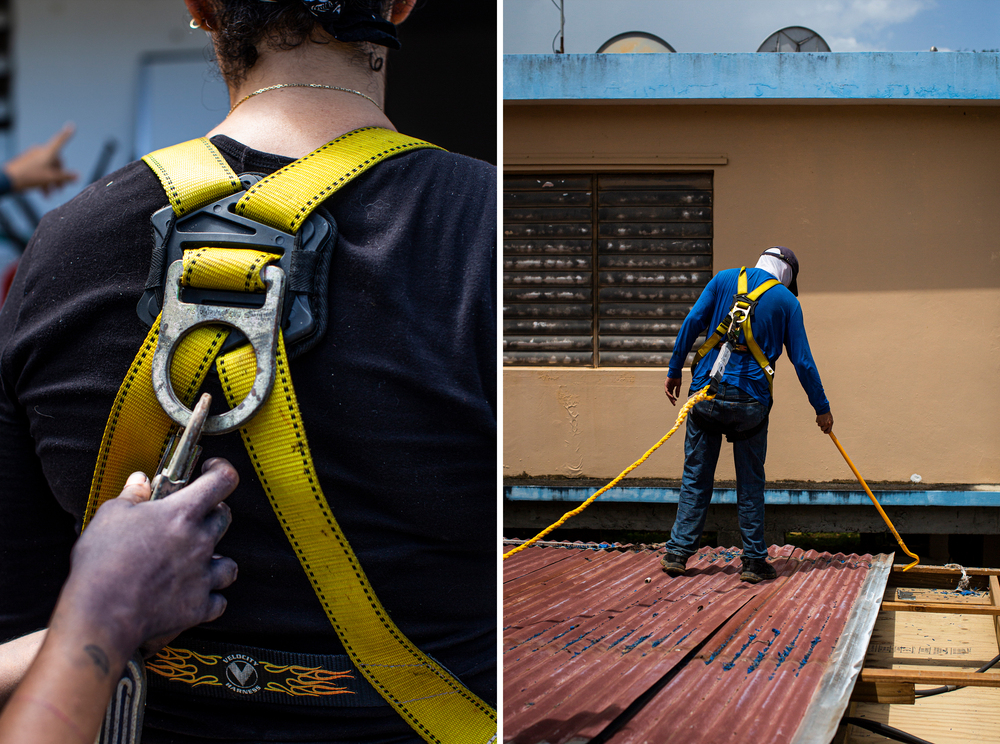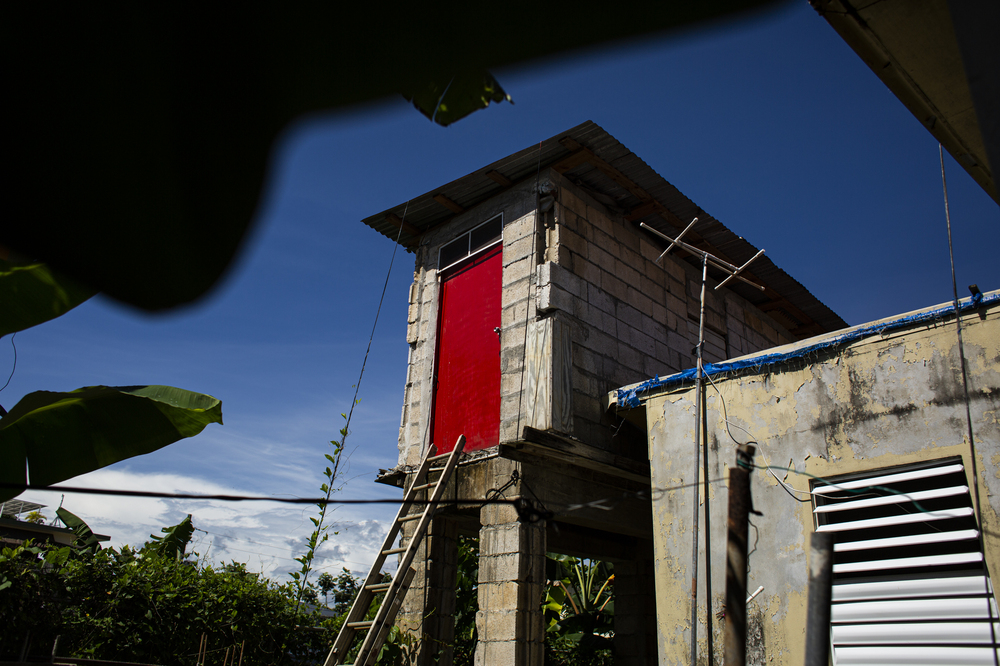
SAN JUAN, Puerto Rico — When they meet the families whose damaged roofs they're about to repair, Luis Marrero's crews often ask which of the hurricanes was to blame. Was it Maria, which devastated Puerto Rico in late September 2017? Or was it Irma, which lashed the island two weeks earlier?
"A lot of them — about 10% — say neither," Marrero said. "They say it was Georges that destroyed their roof."
Hurricane Georges, a category 4 monster, struck Puerto Rico in 1998.
It was a sobering truth for Marrero to absorb. He directs PRoTechos, a nonprofit that was formed after Maria to repair the roofs of families that didn't get government help to do so. But the realization that some people were still living under roofs damaged by a hurricane that long ago drove home the monumental task they faced. The number of people coping with damage inflicted by the storms just five years ago remains vast.
The island's government recently said roughly 3,000 homes damaged by Maria were still covered in the blue FEMA-issued tarps that became a symbol of residents' interminable wait for assistance after the storm.
But no census has been conducted to determine how many roofs are truly still damaged, whether draped in a tarp or not. Marrero estimates – roughly, he said, but conservatively — that the number may be closer to 15,000.
Many are homes that were ineligible for government-funded repairs because they lacked formal title or other documents. But there are also roofs that government-contracted crews fixed so shoddily that their work is already coming undone.
The families beneath those roofs, often poor, usually have few options. They're the ones PRoTechos tries to reach.


In the more than four years since a group of local architects and lawyers founded the nonprofit, it's rebuilt about 130 roofs – six in the first year, and a growing number each year since. Its goal is to scale to 100 annually.
The wood, nails and steel and aluminum panels are often donated by the municipality in which the house they're repairing is located. PRoTechos provides the labor, because building stronger roofs is only half of its mission.
It's also a workforce-development initiative. Much of its funding comes from a federal grant to train the construction workers Puerto Rico will need to complete the billions of dollars' worth of post-Maria reconstruction projects that have yet to begin.
The group's crews are formed by apprentices who learn carpentry on the job and usually acquire enough skill after the three-month program to find work in the construction industry, should they want it.
In September, a crew that was fixing roofs in the northern coastal city of Toa Baja and in La Perla, a working class community at the edge of Old San Juan, spent some time speaking with NPR about their work. Hurricane Fiona would hit Puerto Rico just days later, damaging more roofs but, more significantly, flooding many homes. For weeks after that storm, PRoTechos' teams shifted their focus to help families excavate mud, water, and ruined furniture from inside their houses, before turning their attention back to the structures overhead.
Luis Marrero, director, PRoTechos
"There's a lot of funding coming from the federal government for the reconstruction, but construction firms are lacking workers, and especially carpenters. We go to marginalized areas where they don't necessarily have the knowledge or materials to rebuild their roofs.
"So while we are fixing roofs, we also try to train people from those communities, so that maybe for the next hurricane, the recovery in that community will be faster because they have people already trained that know how to do roofs."
Franceliz Trishkina, instructor and project coordinator
"We try to look at these structures as more than just roofs. When we start working on a new roof, we like to think that what we're doing is undressing it. We undress it, we examine its body, and we dress it again, with the clothes it actually needs.
"We ask ourselves – what does this roof need? Was it poorly dressed? Because if you live in the tropics, you don't need a jacket. If you live in Alaska, you don't want to be dressed in shorts. And we often find houses that need new or different clothes. And when our apprentices look at the house they're working on in that way, they feel a greater responsibility to dress it for what it needs. To do the work well for the families that live there."
Gé Castro Cruz, apprentice
"I spent Hurricane Maria in a house that my grandfather built. We didn't know how it was going to do, and we were kind of nervous, because it's on stilts. But the house was so steady. We could hear the wind and see all the destruction outside, but the house was steady and we felt safe. I'm aspiring to build my own house. So this learning is going to help me out for that.
"I've also been dreaming to be a handyperson for the LGBTQ community. Because in the trans community, it's often difficult to find a safe place to live. And many trans people won't call for repairs because they're scared to let someone into their house, so I want to be able to help my community in that way. But I won't rule out the possibility of getting a job in this. I'm open to what this path brings."
Sonia González Rivera, resident of La Perla
"Maria blew our roof away, along with a couple of the walls from our second story. And we've had leaks on the first floor ever since. Once we saw we weren't going to get any help from FEMA, my husband and I started slowly acquiring the materials to repair the roof ourselves. We got them little by little. Eventually we had what we needed, but we didn't have the money for the labor. And one day, a friend who comes to play bomba music in the neighborhood saw the materials on top of the house and he asked me about them. And he told me not to worry because he was going to connect me with someone who could help. So now we have eight people up there working on it, using the materials we've been storing for almost five years.
"Your home is so important, because each day you wake up and the first thing you do is look around at your surroundings. And if you don't feel good about what you see, then you lose the motivation to go out and work to improve your life."
Emily Alfred, project manager
"We still see a lot of houses with blue tarps on them. And sometimes we see people with materials, but they don't have any labor force to actually build their roof, or they don't have the knowledge of a secure way to rebuild the roof. So they're not really solving the problem, they're just stopping leaks.
"The municipal governments provide some materials for people, but they're not giving them a blueprint for how to build a more secure home. They're not giving them the strongest hurricane ties that they should be using in this very hurricane-prone area. We put a bunch of ties on every roof that we're working on. We maybe go a little bit overboard. But we see a lot of roofs when we open them up that don't have any at all. So it's something we do to ensure their roof is safe for a long time to come."
Sebastián David Fuentes Castro, apprentice
"Everything that wasn't built to standards didn't do well in the hurricane (Maria). So, that also shone a light that there was a lot of substandard work being done. I knew a lot of people whose roofs or sheds blew away and they had no way of putting them back together. Especially older people, who are more vulnerable.
"I think it's very shocking that five years later there are still so many houses with damaged roofs. I would call it unbelievable if I wasn't living through it and seeing it. It's pretty upsetting. That was part of what also inspired me to apply and join. Because these communities, if they're not centered or located in a specific place, they tend to be forgotten. Even the municipality might not pay much attention. This program is definitely filling a very important need for the island and for the community."















